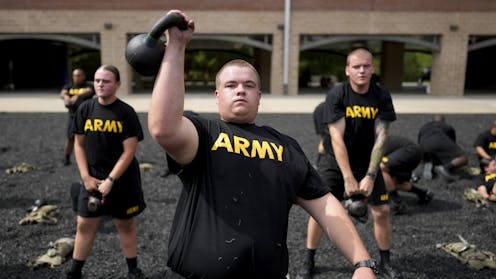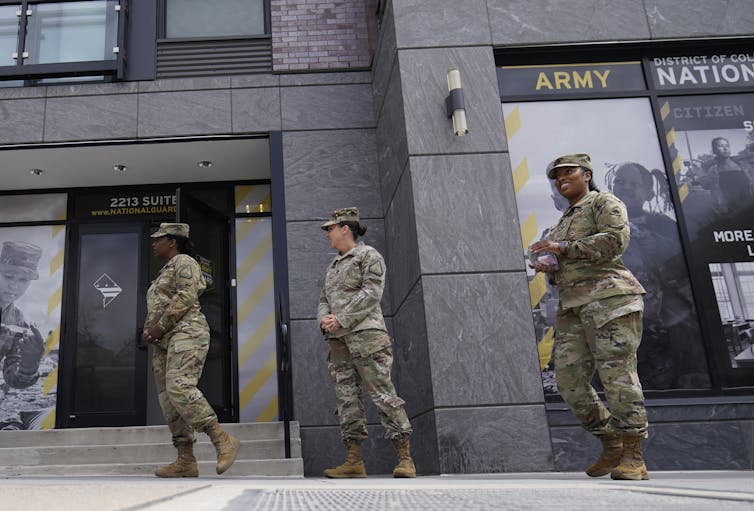US Army’s image of power and flag-waving rings false to Gen Z weary of gun violence − and long-term recruitment numbers show it
- The US Army’s image of power and patriotism may be misleading to Gen Z, who are weary of gun violence and its impact on their mental health and sense of safety.
- The US military is experiencing a multi-year decline in recruitment numbers, with all branches missing their targets in 2022 and 2023, and the Army missing its quota by 25% in 2022.
- Gun violence data suggests that it may be largely to blame for the lack of interest in joining the military, with almost 47,000 Americans dying from gun-related injuries in 2023 and 51 school shootings in 2022.
- The perceptions of gun violence among American youth are having a significant impact on their mental health and sense of safety, with studies linking concern over school shootings to higher rates of anxiety and trauma-related disorders.
- To reverse the slide in recruitment, the military could improve its sensitivity to these concerns by highlighting alternative careers within the services that do not involve front-line combat and physical danger, and prioritizing mental health support as an essential element of military training and lifestyle.

The U.S. Army will celebrate its 250th birthday on Saturday, June 14, 2025, with a parade in Washington, D.C., in which about 6,600 soldiers and heavy pieces of military equipment will roll through the streets. The parade aims to display the Army’s history and power.
“It’s going to be incredible,” President Donald Trump recently said. Trump’s 79th birthday also occurs on June 14.
Despite the festivities, however, the parade will occur amid bleak times for the U.S. military, as it experiences a multiyear decline in recruitment numbers. In the face of a pandemic and a strong civilian job market, the Army, Air Force and Navy all missed their recruitment goals in 2022 and 2023. In 2022, the Army missed its quota by 25%.
In 2024, the U.S. military met its recruitment target, which supports the argument that the bump is not due to Trump, as recruitment levels began to rise again before his reelection. But in some cases, the U.S. military has met its recruitment goals by lowering target numbers.
And as a scholar of terrorism and targeted violence, I believe a close reading of available data on military recruitment suggests U.S. gun violence may be largely to blame for the lack of interest in joining the military.
Gun violence data
Regardless of one’s personal politics, the data on U.S. gun violence makes for painful reading.
Almost 47,000 Americans died from gun-related injuries in 2023. In 2022, there were 51 school shootings in which students were injured or killed by guns. And gun injuries are the leading cause of death for Americans between ages 1 and 19.
Data about the perceptions of gun violence is equally staggering, especially among American youth between ages 14 and 30.
Four out of five American youth believe gun violence to be a problem, and 25% have endured real active-shooter lockdowns, according to data compiled by Everytown for Gun Safety, where I serve as a survivor fellow, the Southern Poverty Law Center and American University’s Polarization and Extremism Research and Innovation Lab.
Moreover, these perceptions have considerable impacts on youth mental health and their sense of safety. Studies have linked concern over school shootings among adolescents with higher rates of anxiety and trauma-related disorders.
As Arne Duncan, who served as President Barack Obama’s secretary of education during the Sandy Hook tragedy, said in 2023: “Unfortunately, what’s now binding young people across the country together is not joy of music, or sports, or whatever, it’s really the shared pain of gun violence – and it cuts through race and class and geography and economics.”
National security threat
In the past couple of years, polls taken of Generation Z youth, born between 1997 and 2012, suggest mental health and mass shootings are among the most important political issues motivating this band of voters.
Gun violence, in other words, is a national security emergency, undermining the U.S. government’s ability to protect its citizens in their schools, places of worship and communities.
As former Marine Gen. John Allen wrote in 2019: “Americans today are more likely to experience gun violence at home than they might in many of the places to which I deployed in the name of defending our nation.”

AP Photo/Mariam Zuhaib, File
Rewriting American culture
Accordingly, gun violence has undercut American patriotism, corroding the U.S. government’s soft power within its own borders. Generation Z, termed by some as the “lockdown generation,” is often derided as less patriotic than its predecessors.
Also, the belief in American exceptionalism is dropping among millennials, born between 1981 and 1996. That perception is combined with less confidence in U.S. global engagement and the efficacy of military solutions.
American culture has long inspired military service, with recruits seduced by action movies and promises of heroic returns to the U.S. But American culture today is being rewired into one of suffering, pain and victimhood.
A fear of violence
Gun violence destroys youth tolerance for the violence that defines a career in the U.S. military.
Internal U.S. military surveys of young Americans show that “the top three reasons young people cite for rejecting military enlistment are the same across all the services: fear of death, worries about post-traumatic stress disorder and leaving friends and family — in that order.”
Generations already suffering a shattered sense of safety and place do not see the military as a viable option.
The explanations the U.S. Defense Department gives for dismal recruitment levels focus on the younger generation’s supposed lack of backbone or hatred of America.

Vanessa R. Adame/U.S. Air Force via AP
Republicans, including Secretary of Defense Pete Hegseth, have blamed alleged “wokeness” for low recruitment levels.
And the Trump administration’s statements about improving recruitment numbers over the past several months overlook both a late Biden-era surge after a pandemic slump as well as the reality that numbers remain depressed due to military services repeatedly lowering their recruitment goals.
Very rarely are introspective questions publicly debated today about the objective attractiveness of military service or the appetite for violence among young people. The problem, I believe, is not that young people are insufficiently patriotic – it’s that they have already been fighting a war, daily, for their entire lives.
In reversing the slide in recruitment, then, the military could improve its sensitivity to these important concerns.
Highlighting the range of careers within the services that do not involve front-line combat and physical danger could encourage more reluctant would-be recruits to volunteer.
Mental health support also could be made an essential element of military training and lifestyle − not a resource only for those bearing the hidden side-effects of life in the ranks. Encouraging those suffering from treatable mental health issues to seek meaning in service could also boost recruitment numbers.
![]()
Jacob Ware is a gun violence survivor and serves as a Survivor Fellow at Everytown for Gun Safety.
